Discover the best AI documentation generator tools of 2025. Improve your workflow with top-rated solutions designed to streamline your documentation process.
Creating and maintaining software documentation is time-consuming. AI documentation generators offer a solution by automating this process, allowing developers to focus on building. This listicle presents seven leading AI-powered documentation generators for 2025, helping you choose the right tool to streamline your workflow. Discover how these tools, including DocuWriter.ai and Jasper AI, can improve your documentation process. From GitBook to Mintlify, explore solutions designed for teams of all sizes.
In the rapidly evolving landscape of software development, efficient and accurate documentation is paramount. DocuWriter.ai emerges as a leading AI documentation generator, offering a comprehensive solution for automating the often tedious process of creating and maintaining code and API documentation. This platform leverages the power of artificial intelligence to drastically reduce the time and effort required for documentation, allowing developers to focus on what they do best: building innovative software. By automating this critical yet time-consuming aspect of the software development lifecycle, DocuWriter.ai empowers teams to improve code quality, enhance collaboration, and accelerate project delivery.
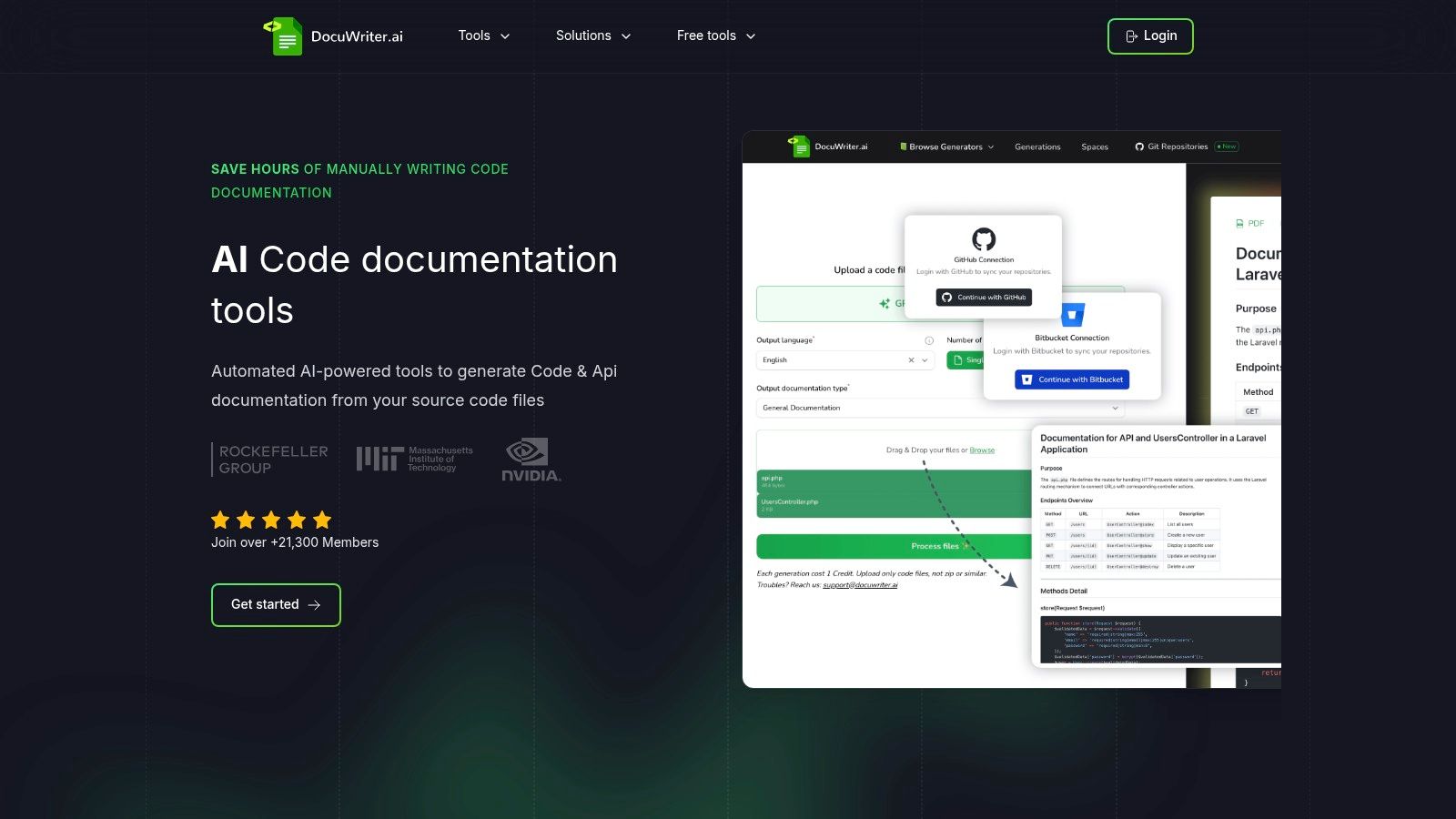
DocuWriter.ai distinguishes itself through its multifaceted approach to documentation. It doesn’t just generate text; it provides a suite of tools designed to streamline the entire development workflow. Imagine effortlessly creating UML diagrams to visualize complex systems, automatically refactoring code for improved readability and maintainability, or even converting code between different programming languages. These features, coupled with the core functionality of AI-powered documentation generation, make DocuWriter.ai a valuable asset for any development team.
Consider the practical applications. A startup developing a new API can use DocuWriter.ai to generate comprehensive API documentation in a fraction of the time it would take manually, freeing up valuable resources for product development and marketing. An established enterprise can leverage the platform to ensure consistency and accuracy across its vast codebase, minimizing the risk of errors and improving the overall quality of its software. Even individual developers and freelancers can benefit from the automation and efficiency DocuWriter.ai provides, allowing them to deliver professional-quality documentation with minimal effort.
DocuWriter.ai’s flexible subscription plans cater to a wide range of users. From starter plans for individuals and small teams to enterprise-level subscriptions with advanced features and scalable usage limits, there’s an option for every need and budget. While the subscription model may be less suitable for very small, infrequent projects, the time savings and increased productivity offered by the platform often outweigh the cost for regular users. Higher-tier plans unlock additional features, such as automatic Git documentation integration, allowing seamless synchronization between code changes and documentation updates, and role-based team management, facilitating collaboration within larger teams.
This AI documentation generator boasts significant advantages, notably its ability to drastically reduce manual documentation time. The platform’s AI algorithms generate content quickly, allowing developers to produce high-quality documentation within minutes. Consistency and accuracy are also hallmarks of DocuWriter.ai. The platform ensures that documentation adheres to pre-defined standards, minimizing inconsistencies and improving overall readability. The comprehensive feature set, including UML diagram generation, code refactoring, and language conversion, further enhances its value proposition, consolidating multiple tools within a single platform.
However, as with any tool, DocuWriter.ai has some limitations. While the subscription-based pricing offers flexibility, it may not be the most cost-effective solution for extremely small projects or occasional users. Additionally, some advanced features, like automatic Git documentation and role-based team management, are reserved for higher-tier plans, which may be a barrier for some users.
The platform’s success is reflected in its user base of over 21,300 members and the reported 87,500 hours saved in documentation time. Testimonials from industry experts, including CTOs and engineers from leading tech companies like NVIDIA, further validate its effectiveness. Available on the VSCode marketplace, with responsive customer support and educational discounts, DocuWriter.ai positions itself as a valuable tool for accelerating development workflows and elevating software project quality. Its availability on the VSCode marketplace simplifies integration into existing development environments for many developers. By streamlining documentation, DocuWriter.ai allows developers to focus on what they do best: building and innovating. For more information and to explore the platform’s features, visit their website: https://www.docuwriter.ai/.
GitBook is a robust platform designed to streamline the creation, organization, and maintenance of documentation using the power of AI. For teams struggling with keeping their documentation updated, comprehensive, and accessible, GitBook offers an appealing solution with features like AI-powered content suggestions, automated content generation, and intelligent document organization. This makes it a strong contender for anyone looking for an efficient ai documentation generator. This is particularly valuable for software developers, engineering teams, and tech startups who need to maintain extensive documentation for their projects. Its integration with existing developer workflows and collaborative editing features, complemented by real-time AI assistance, further solidify its place as a modern documentation platform.
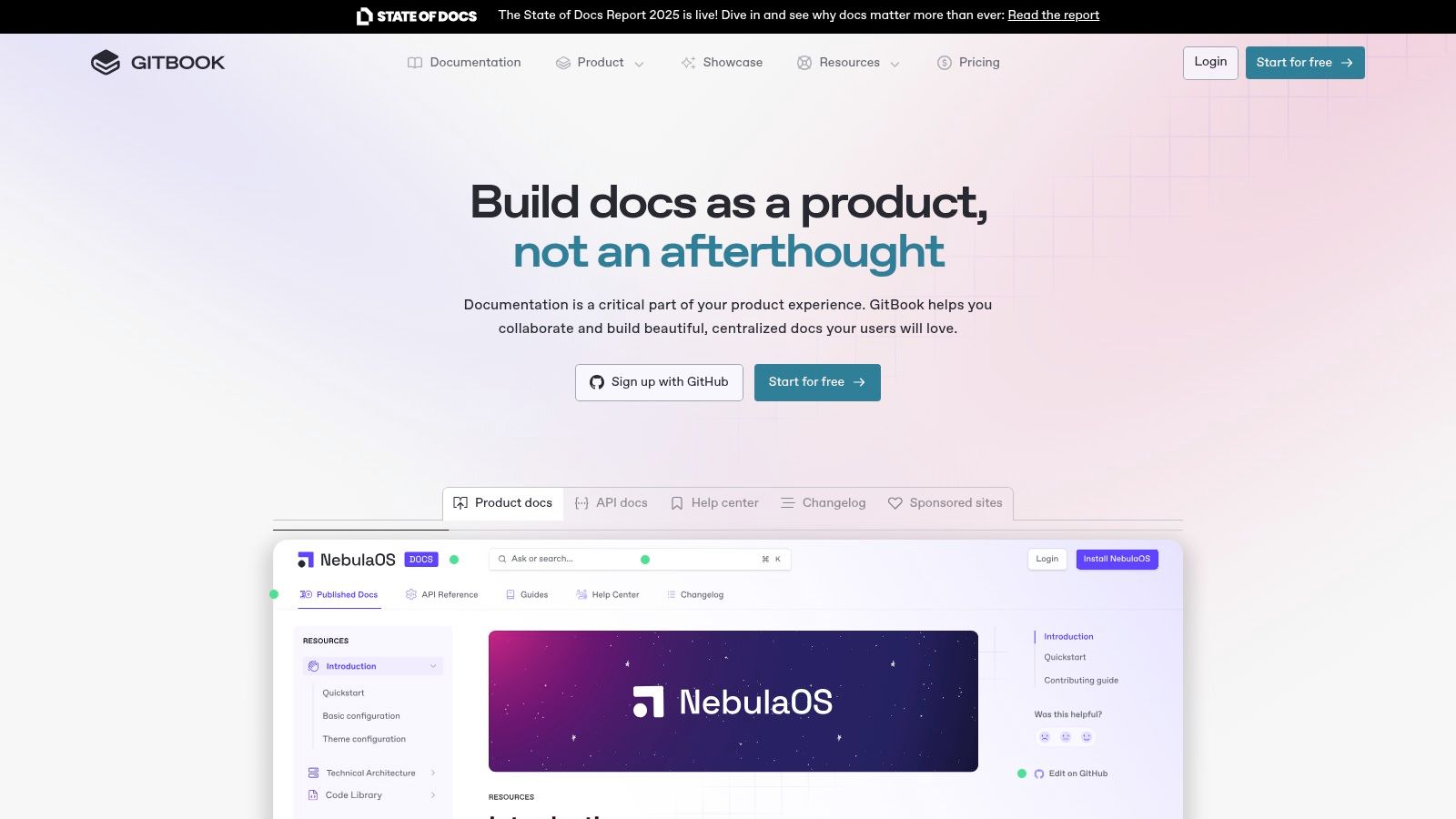
One of GitBook’s key strengths lies in its AI-powered assistance. The platform leverages AI to provide content suggestions and auto-completion, accelerating the writing process and ensuring consistency. Its intelligent document organization capabilities automatically structure content, making it easier to navigate and maintain. Furthermore, the real-time collaborative editing feature, coupled with AI assistance for writing and structuring, promotes seamless teamwork and ensures that everyone stays on the same page. The ability to generate content automatically from code comments is a significant time-saver for developers, ensuring documentation stays synchronized with the latest codebase. For a deeper look into how GitBook facilitates API documentation, Learn more about GitBook.
GitBook seamlessly integrates with Git repositories and other developer tools, allowing teams to manage their documentation within their existing workflows. This tight integration eliminates context switching and simplifies version control for documentation. For example, developers can directly link code snippets and commit messages to their documentation, ensuring traceability and accuracy. This integration is invaluable for Agile teams that prioritize continuous integration and continuous delivery.
While GitBook offers a free tier, accessing the full suite of AI-powered features requires a paid subscription. The pricing structure is tiered, with options for individuals, teams, and enterprises. The cost may be a limiting factor for smaller teams or individual developers with limited budgets. While the platform is generally intuitive, the sheer number of features can be overwhelming for those with simpler documentation needs. Furthermore, the customization options in the free tier are somewhat restricted, potentially limiting branding and styling possibilities.
Despite these limitations, GitBook stands out for its comprehensive API documentation tools. It provides features specifically designed for creating, managing, and publishing API documentation, including interactive API explorers and code samples. This makes it an excellent choice for developers who need to create comprehensive and user-friendly API documentation. The platform also offers robust search functionality, making it easy for users to find the information they need quickly.
Implementing GitBook is relatively straightforward. Teams can sign up for an account, create a new space for their documentation, and begin writing. The platform offers a variety of templates and pre-built structures to help users get started quickly. Connecting GitBook to existing Git repositories is a simple process, allowing teams to quickly integrate their documentation into their development workflows. While the platform offers a wealth of features, the intuitive user interface makes it easy to navigate and utilize these functionalities effectively.
In comparison to other ai documentation generators, GitBook shines with its tight integration with development workflows and its powerful AI features. While tools like Document360 and Read the Docs offer robust documentation solutions, GitBook differentiates itself with its focus on AI-assisted writing and intelligent content organization. It caters specifically to the needs of software development teams by integrating directly with their existing tools and processes.
In conclusion, GitBook’s focus on AI-powered features, seamless integration with developer workflows, and collaborative capabilities make it a powerful ai documentation generator for teams seeking efficiency and quality in their documentation process. While cost and complexity may be considerations for smaller teams, the benefits offered by GitBook make it a compelling choice for those looking to modernize their documentation practices.
Notion AI stands out as a versatile AI documentation generator, seamlessly integrated within the popular Notion workspace platform. This makes it a powerful tool for individuals and teams looking to streamline their documentation processes within a unified environment. It leverages the power of natural language processing to assist users in generating various types of content, including comprehensive documentation, concise summaries, and intricate technical write-ups. By simply providing natural language prompts, users can direct Notion AI to create structured documentation, expand on outlines, and intelligently organize information, saving valuable time and effort. Its strength lies in its ability to create rich and interconnected documentation that seamlessly combines text, databases, and multimedia elements, catering to a variety of documentation needs. This positions Notion AI as a compelling solution for those seeking a centralized and efficient platform for all their documentation requirements.
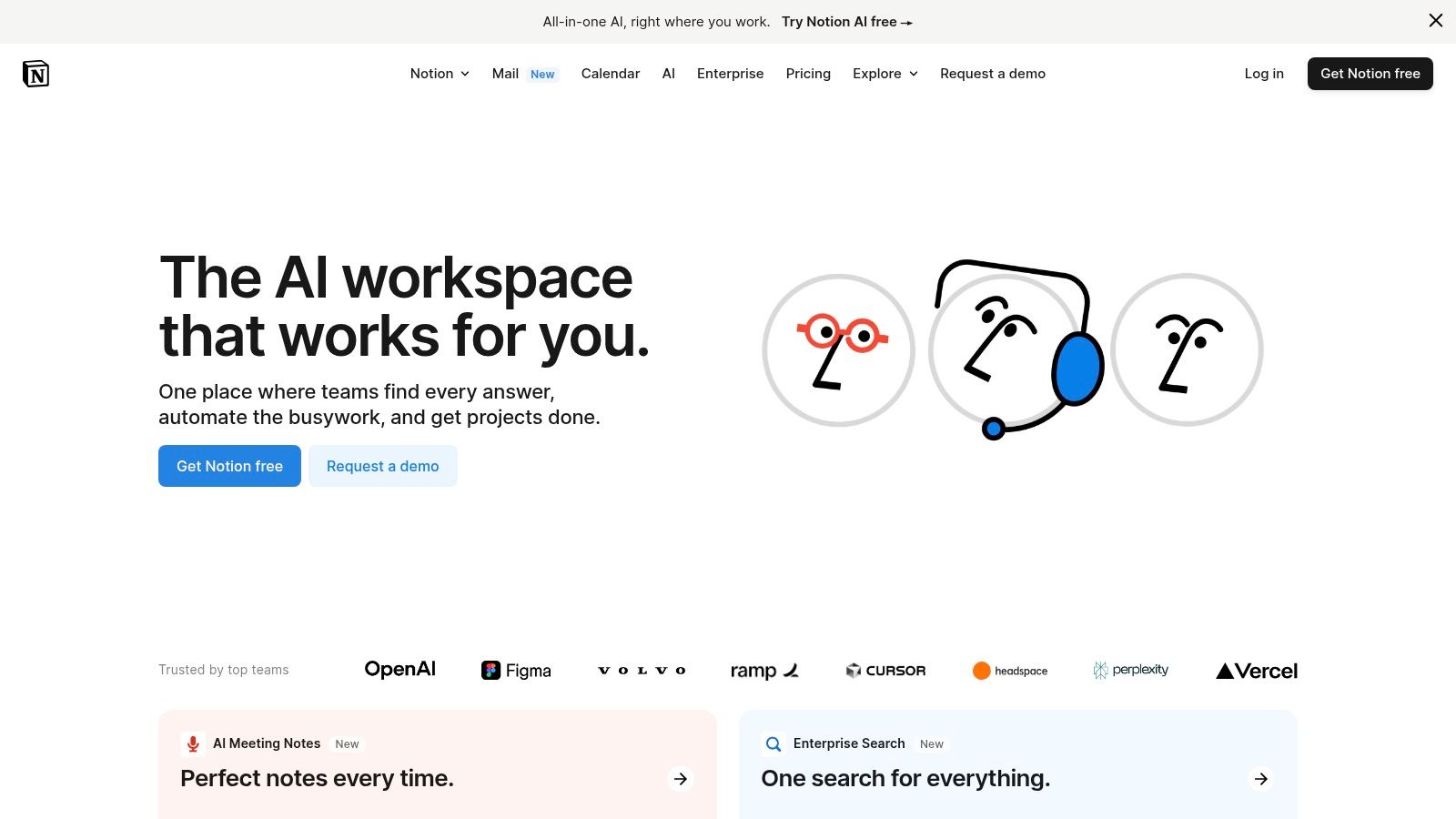
One of the key advantages of Notion AI for software developers, engineers, and DevOps teams is its capacity to generate structured documentation. Whether it’s API documentation, system architecture overviews, or codebase explanations, Notion AI can assist in creating consistent and well-organized documentation that’s easily searchable and navigable. For startups and small business owners, Notion AI offers a streamlined approach to creating everything from product documentation and user manuals to internal wikis and knowledge bases. Its template-based documentation creation further simplifies the process, providing a starting point for various documentation types and promoting consistency.
Notion AI’s integration with databases and structured content is particularly valuable for technical teams. This allows for dynamic documentation that updates as the underlying data changes, ensuring that documentation always reflects the current state of a project. Imagine a scenario where a web developer is documenting a complex database schema. Notion AI can help automate parts of this process, pulling information directly from the database to create tables, diagrams, and textual descriptions, saving the developer considerable time and reducing the risk of errors. App developers can similarly benefit, using Notion AI to generate documentation for their app’s functionality, integrating with their development environment to maintain up-to-date records.
Notion AI offers several advantages that make it a strong contender in the ai documentation generator landscape. Its collaborative editing and commenting features facilitate teamwork, allowing multiple users to work on documentation simultaneously and provide feedback directly within the platform. The multi-format content support, encompassing text, tables, and media, further enhances the richness and comprehensiveness of the generated documentation. Compared to other AI-powered documentation tools, Notion AI’s affordability, especially given its integration with the broader Notion workspace, makes it an attractive option, particularly for smaller teams and individuals. Notion AI offers a free trial, with paid plans starting at $8 per user per month (billed annually).
However, Notion AI is not without its drawbacks. The breadth of features within the Notion platform can result in a learning curve, especially for users new to the system. While the AI writing assistant is generally helpful, its responses can occasionally lack technical accuracy, requiring careful review and editing. The current selection of specialized documentation templates, although growing, is still relatively limited. While core Notion features are available for free, access to the AI capabilities requires a paid subscription.
Despite these limitations, Notion AI’s tight integration with the Notion workspace, its collaborative features, and flexible content organization make it a compelling option for generating documentation. For users already working within the Notion ecosystem, the addition of AI capabilities provides a significant productivity boost. For those looking for a centralized platform for documentation creation, project management, and knowledge sharing, Notion AI, accessed via the Notion website at https://www.notion.so, offers a powerful and integrated solution. Implementing Notion AI within a team is relatively straightforward, involving subscribing to a paid Notion plan and familiarizing team members with the AI features. By leveraging its strengths and mitigating its limitations, Notion AI can be a valuable asset for any team striving to improve its documentation workflow.
Scribe stands out as a powerful AI documentation generator, specifically designed to simplify the creation of process documentation. Unlike traditional methods that involve tedious manual writing and screenshotting, Scribe automates the entire process by recording user actions and transforming them into comprehensive, step-by-step guides. This makes it an invaluable tool for software developers, engineers, startups, small business owners, and anyone who needs to document workflows quickly and efficiently. It’s particularly well-suited for generating how-to guides, standard operating procedures (SOPs), training materials, and knowledge base articles related to specific software applications or web platforms. By simply performing the task once, Scribe observes and translates the actions into clear, documented processes, eliminating the bottleneck of manual documentation and freeing up valuable time for other essential tasks.

Scribe’s strength lies in its simplicity and intuitive design. The core functionality revolves around automatic screen recording and documentation generation. As a user performs a task, Scribe captures screenshots, tracks clicks and keyboard inputs, and then uses AI to structure these actions into a coherent, step-by-step guide. Each step is visually documented with a screenshot and a concise description, ensuring clarity and easy comprehension. This visual approach is especially beneficial for training and onboarding, enabling new team members or users to quickly grasp complex procedures.
For developers and engineering teams, Scribe offers a streamlined way to document code deployment processes, bug reproduction steps, or software testing procedures. This eliminates ambiguity and ensures consistency across the team. Startups can leverage Scribe to create internal documentation for their products or services, facilitating efficient knowledge sharing and reducing reliance on institutional knowledge. Similarly, small business owners can utilize Scribe to document key operational processes, from customer service protocols to inventory management, ensuring smooth operations even with staff changes.
Scribe integrates with a variety of popular business tools, enhancing its versatility and utility within existing workflows. While specific integrations are subject to change, check the Scribe website for the most up-to-date information. This interoperability allows users to seamlessly incorporate Scribe into their preferred project management platforms, communication channels, or learning management systems.
While Scribe excels in process documentation, it’s important to acknowledge its limitations. It’s less suitable for creating conceptual or highly technical documentation that requires in-depth explanations or theoretical background. The focus is primarily on documenting how to do something, rather than why or the underlying technical details. Another consideration is the free plan’s usage limitations. While it offers a good starting point for exploring Scribe’s capabilities, larger teams or organizations with extensive documentation needs may require a paid subscription to unlock unlimited usage. Pricing details are available on the Scribe website (https://scribehow.com), and typically include tiered plans based on usage and features. Finally, privacy concerns surrounding screen recording should be addressed. Sensitive data should be masked or excluded from recordings, especially when dealing with personally identifiable information.
Implementing Scribe is remarkably straightforward. Typically, it involves installing a browser extension or a desktop application. Once installed, users can initiate a recording session with a single click. After performing the desired task, Scribe automatically generates the documentation, which can then be edited, customized, and shared. Users can annotate screenshots, add clarifying text, and reorder steps as needed. This flexibility allows for fine-tuning the documentation to ensure accuracy and completeness.
Compared to other AI documentation generators that might focus on code documentation or API specifications, Scribe’s unique value proposition is its ease of use and focus on visual, process-based documentation. While tools like Swagger are essential for developers documenting APIs, Scribe complements such tools by providing a way to document the practical application and usage of those APIs within specific workflows. In essence, Scribe bridges the gap between technical documentation and practical, user-focused guides.
Mintlify stands out as a robust AI documentation generator explicitly tailored for developers. Its primary focus is on automating the often tedious process of creating and maintaining high-quality, user-friendly documentation for codebases, APIs, and SDKs. This makes it a valuable tool for software developers, engineering teams, tech startups, and anyone involved in creating and maintaining software projects. It streamlines documentation workflows, allowing developers to focus more on coding and less on writing documentation. By leveraging AI, Mintlify intelligently analyzes code and generates comprehensive documentation, saving significant time and effort. This automated approach also helps ensure consistency and accuracy across all documentation.
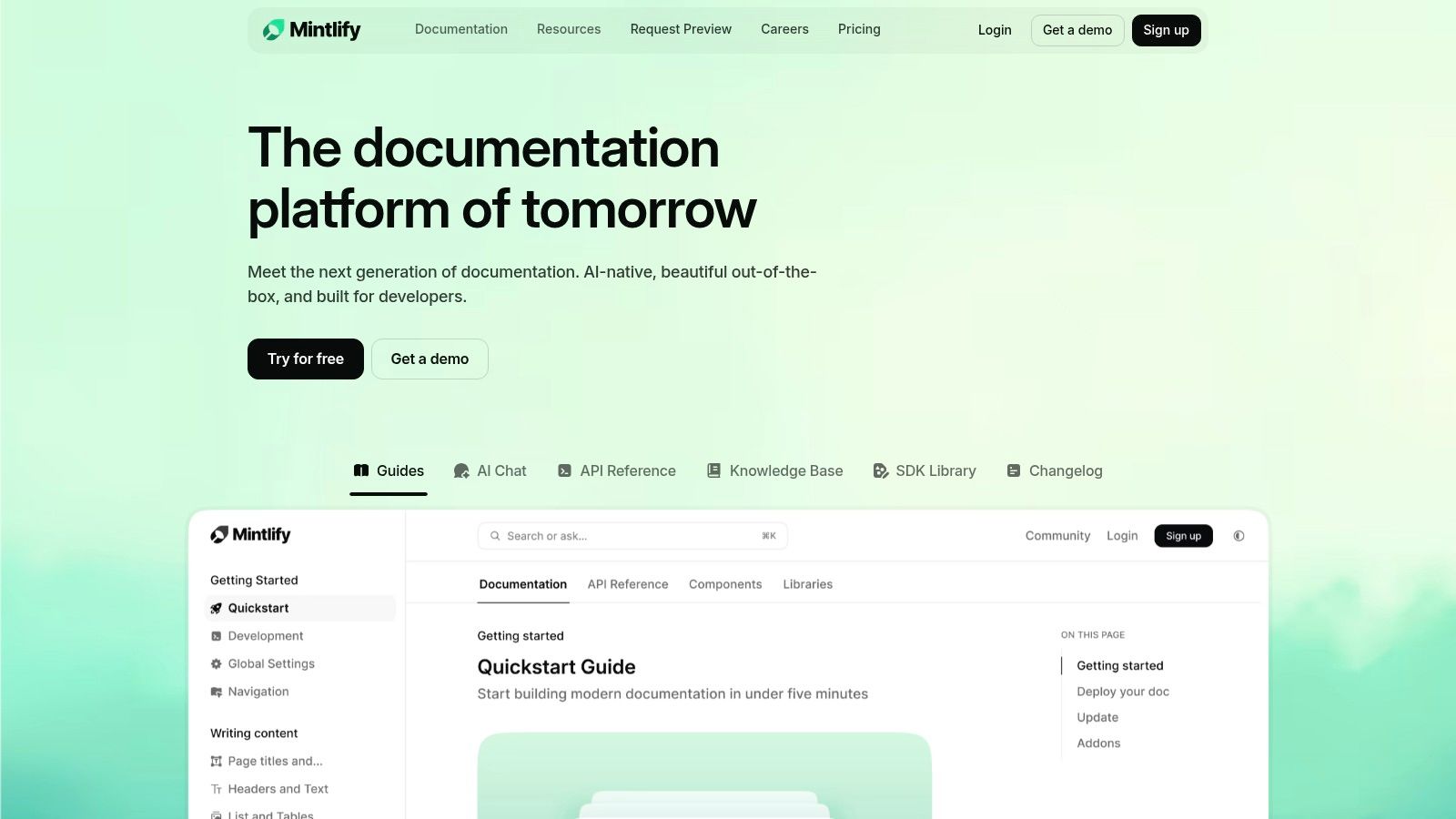
One of Mintlify’s key strengths lies in its automated code documentation generation. It automatically extracts information from code comments, function signatures, and other relevant code elements to create comprehensive documentation. This significantly reduces the manual effort required to write and update documentation, especially in dynamic projects where code changes frequently. Moreover, Mintlify goes beyond basic code documentation by automatically creating API references. This is particularly useful for developers building APIs or SDKs, as it ensures that the API documentation is always up-to-date and synchronized with the latest code.
Mintlify also prioritizes the aesthetics and usability of documentation. It offers a range of beautiful, customizable documentation themes, allowing developers to create visually appealing and professional documentation sites. These themes are responsive, ensuring a seamless viewing experience across different devices. Furthermore, Mintlify recognizes the importance of discoverability. The platform generates search-optimized content, leveraging SEO best practices to improve the visibility of documentation in search engine results. This is crucial for open-source projects and public APIs, where discoverability is essential for adoption and usage.
Integration with popular development tools and repositories is another significant advantage of Mintlify. This seamless integration streamlines workflows by allowing developers to directly generate and update documentation from within their preferred development environments. For those interested in delving deeper into the platform’s capabilities, you can learn more about Mintlify.
While Mintlify boasts several advantages, it also has certain limitations. Its primary focus on technical documentation means it might not be the ideal solution for projects requiring extensive non-code documentation, such as user manuals or marketing materials. While Mintlify offers a free tier, its pricing can become relatively expensive for larger teams with extensive documentation needs. Another potential drawback is the technical setup and configuration required to integrate Mintlify into a project. While this process is generally straightforward, it might require some technical expertise, especially for complex projects.
For instance, a team developing a complex REST API could leverage Mintlify to automatically generate comprehensive API documentation, including detailed descriptions of endpoints, parameters, and response formats. This automation would save the team countless hours of manual documentation effort, allowing them to focus on development and testing. Similarly, an open-source project could use Mintlify to create searchable and well-organized documentation, improving the project’s discoverability and attracting more contributors.
Mintlify earns its place in this list due to its specialized focus on developer and API documentation, its excellent code-to-docs automation, and its ability to create modern and responsive documentation sites. While its focus on technical documentation and pricing might be limitations for some, its strengths make it a powerful tool for streamlining documentation workflows and improving the quality and discoverability of technical documentation. If your primary need is to generate high-quality, easily searchable documentation directly from your codebase, then Mintlify is a compelling option worthy of consideration. However, if your documentation needs extend beyond technical content, or if budget is a significant constraint, exploring alternative solutions might be advisable.
Document360 stands out as a robust and comprehensive knowledge base platform specifically designed to leverage AI for streamlining the creation, management, and optimization of documentation. This makes it a compelling choice for businesses seeking to improve their documentation workflows and enhance content quality with the help of artificial intelligence. It’s a valuable tool for creating customer-facing documentation, internal knowledge bases, and self-service help centers, offering AI assistance throughout the entire content lifecycle. Its focus on providing AI-powered features within a broader knowledge management system differentiates it from simpler AI documentation generators, making it suitable for teams who need more than just automated content creation.
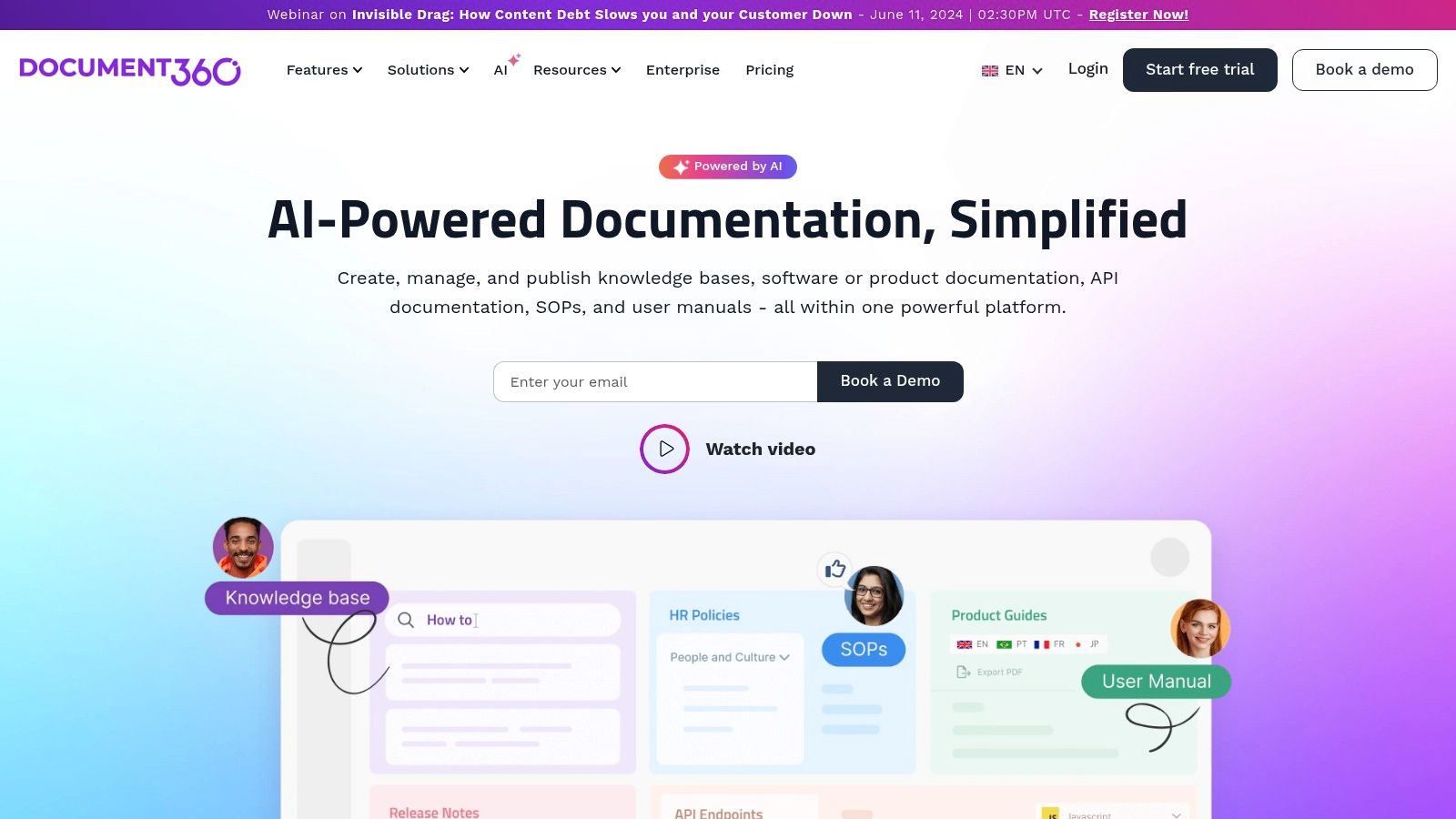
For software developers, Document360 offers significant advantages. Imagine effortlessly creating API documentation or SDK guides with the AI-powered content writing assistance. The platform can analyze your existing code and suggest content, saving developers valuable time and ensuring consistency. Tech startups and small business owners, often juggling multiple roles, can benefit from automated content optimization suggestions, helping them create professional-grade documentation without dedicated technical writing resources. Similarly, for engineering teams, Document360’s intelligent search capabilities can improve internal knowledge sharing, making it easier to find solutions to common problems and reduce duplicated effort. Web and app developers can create user-friendly documentation that improves customer satisfaction and reduces support tickets. DevOps teams can utilize Document360 to maintain accurate and up-to-date documentation for their complex infrastructure and deployment processes, minimizing errors and improving collaboration.
One of Document360’s key strengths lies in its AI-powered content writing assistance. This feature goes beyond simple grammar and style checks. It provides intelligent content suggestions, helping writers create more comprehensive and accurate documentation. This feature is particularly useful for complex technical topics where precision and clarity are paramount. The automated content optimization suggestions further enhance the quality of documentation by recommending improvements to readability, SEO, and overall content structure.
Furthermore, Document360’s intelligent search and content discovery features empower users to quickly find the information they need. This is crucial for both internal knowledge bases and customer-facing documentation. The platform’s multi-language content generation capabilities are a boon for businesses operating in global markets, allowing them to easily create documentation in multiple languages. Analytics-driven content improvement recommendations provide valuable insights into how users interact with the documentation, allowing teams to identify areas for improvement and optimize content for maximum effectiveness.
While Document360 boasts a comprehensive feature set, potential users should consider its pricing structure. It generally falls into a higher pricing tier compared to some competitors offering basic AI writing tools. The complexity of setting up advanced features may require some dedicated time and effort, potentially necessitating additional training or support. While its AI capabilities are continually evolving and improving, some features are still under development and may not be as mature as those offered by more specialized AI writing tools. Finally, compared to other documentation generators, Document360 has fewer direct integration options with third-party platforms, which might be a limitation for some workflows.
Implementation of Document360 starts with defining your documentation needs and choosing the appropriate plan based on features and user count. Populating the knowledge base with initial content is a key step, and the platform offers various import options. Customizing the look and feel to match your branding is essential for creating a seamless user experience. Training your team on how to effectively use the platform’s features, particularly the AI-powered functionalities, will maximize its value. Regularly reviewing analytics and acting upon the content improvement recommendations will help optimize the documentation over time.
In summary, Document360’s position in this list is warranted due to its comprehensive blend of knowledge base features and AI-powered assistance. It’s ideal for organizations that prioritize robust documentation within a centralized platform and are willing to invest in a more premium solution. While the pricing and complexity may be higher than some competitors, the breadth of features, strong analytics, and excellent customer support make it a compelling choice for teams serious about creating high-quality, AI-driven documentation. You can explore more about Document360 and its offerings on their website: https://document360.com
Jasper AI is a prominent player in the AI documentation generator landscape, offering a powerful and versatile solution for creating various types of documentation. From intricate technical manuals to concise user guides and compelling marketing copy, Jasper AI leverages advanced natural language generation to produce high-quality content. Its strength lies in its ability to transform brief inputs and outlines into comprehensive, well-structured documents, saving users significant time and effort. This positions Jasper as a valuable tool for software developers, engineers, startups, and businesses seeking to streamline their documentation processes.

One of Jasper AI’s key strengths is its specialized templates designed for specific document types. These templates provide a framework and pre-filled sections, guiding users through the creation process and ensuring consistency. For software developers, this is particularly useful for generating API documentation, SDK guides, or code examples. Similarly, marketing teams can leverage templates for creating engaging product descriptions, website copy, or social media posts. The multi-language content generation feature further broadens Jasper’s applicability, enabling teams to create documentation for global audiences.
A standout feature of Jasper AI is its focus on brand voice and consistency. Users can customize the platform to align with their brand’s specific style and terminology, ensuring that all generated documentation maintains a cohesive tone and messaging. This is crucial for building brand recognition and maintaining a professional image. For tech startups looking to establish a strong brand identity, this feature allows them to infuse their documentation with a unique personality.
For developers and engineers, Jasper AI can be integrated into existing workflows through its integrations with popular content management systems (CMS). This streamlined integration allows for seamless transfer of generated documentation directly into the CMS, eliminating manual copy-pasting and reducing the risk of errors. DevOps teams, in particular, can benefit from this integration by automating the documentation process within their CI/CD pipelines.
While Jasper AI offers numerous advantages, it also has some limitations. One notable drawback is its pricing structure. Jasper AI’s plans can be relatively expensive, particularly for larger teams or organizations with extensive documentation needs. Smaller businesses or freelancers might find the pricing prohibitive. Furthermore, while Jasper AI is highly sophisticated, achieving optimal results often requires careful prompt engineering. Users need to provide clear and specific instructions to guide the AI’s content generation. Simply inputting a keyword like “ai documentation generator” into Jasper AI won’t necessarily produce a polished document. A well-crafted prompt, outlining the desired content, structure, and target audience, is essential for maximizing the platform’s effectiveness.
Another limitation is the lack of built-in documentation hosting or organization features. While Jasper AI generates the content, it doesn’t provide a platform for storing, managing, or version controlling the generated documentation. Users need to rely on external tools or platforms for these functions. Finally, while Jasper excels at generating text, it can sometimes produce inaccurate technical information, particularly when dealing with complex or niche topics. Thorough review and oversight by subject matter experts are crucial to ensure the accuracy and reliability of the generated content.
Despite these limitations, Jasper AI’s advanced natural language generation, specialized templates, and brand customization features make it a compelling option for generating high-quality documentation. Its strengths lie in its ability to create comprehensive content from brief inputs, freeing up valuable time for teams to focus on other critical tasks. While its pricing might be a barrier for some, the platform’s powerful capabilities and continuous updates justify its place among leading ai documentation generators. The website, https://www.jasper.ai, provides further details on pricing, features, and use cases.
Selecting the perfect AI documentation generator from the array of options, including tools like DocuWriter.ai, GitBook, Notion AI, Scribe, Mintlify, Document360, and Jasper AI, requires careful consideration of your specific needs. We’ve explored several leading AI documentation generators, each offering unique strengths and weaknesses. Key takeaways include the importance of considering the type of documentation required (API documentation, user guides, code documentation, etc.), team size, budget constraints, and necessary integrations. Successfully implementing an AI documentation generator relies on understanding these factors and matching them with the appropriate tool. For example, a small startup with limited resources might prioritize a user-friendly, cost-effective solution like Mintlify, whereas a large enterprise seeking comprehensive API documentation might lean towards a robust platform like Document360.
If you’re looking to improve not only documentation but also your overall ideation process, consider exploring how AI can further enhance your creative workflow. Sometimes, a fresh perspective is all it takes to overcome a creative block. For more inspiration on how AI can boost your creative process, explore these innovative techniques to ignite ideas: spark creativity from AI Tools Brief.
Efficient documentation is crucial for any successful software project, and leveraging the power of an AI documentation generator can significantly streamline this process. By carefully evaluating the features and benefits of each AI documentation generator and aligning them with your project’s specific demands, you can empower your development team, improve collaboration, and ultimately deliver a superior product.
Ready to experience the future of documentation? Streamline your workflow and create stunning documentation effortlessly with the power of AI. Give DocuWriter.ai a try and see how this advanced AI documentation generator can transform your project.